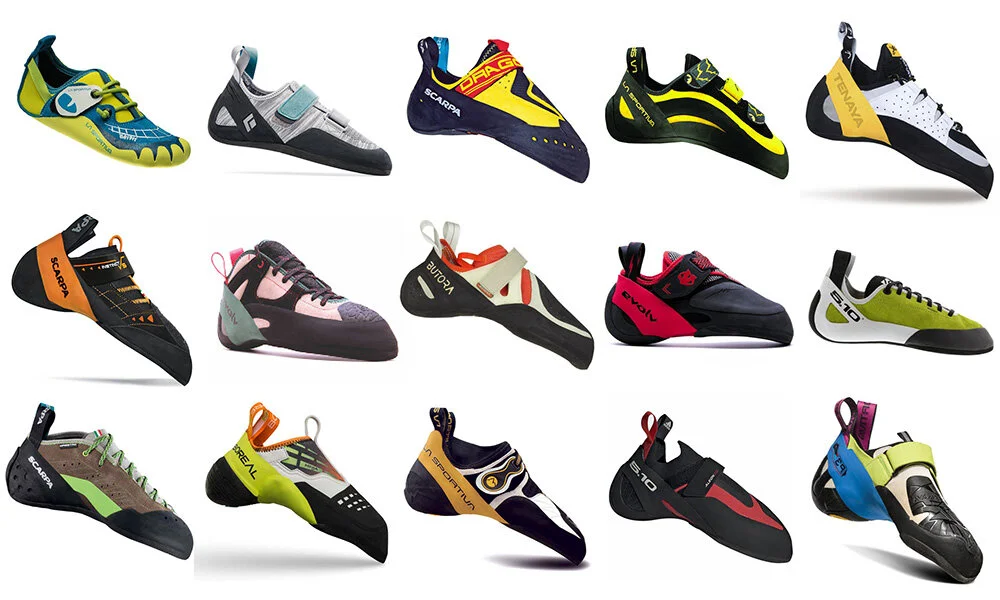Choosing climbing shoes
I’ve been fitting climbing shoes onto feet for 26 years - here’s a few tips of the trade when looking to buy your first pair of climbing shoes (most of these tips are also relevant for expert climbers!)
Fit
The most important thing to remember is to get a good fit. Sounds obvious but unlike street shoes you can’t get away with a bit of space or wiggle room here and there. You need to find a shoe that fits your foot shape as accurately as possible.
Pain
Then they need to be tight but not painful - a fine line. A tight shoe will help you to stand on tiny edges, increasing your control and confidence (very helpful when it comes to improving). You should look for ‘bearable discomfort’. Total comfort will mean a slightly roomy fit that is nice to wander about in but less good for climbing well, and total discomfort (or bloomin’ painful) will mean superb performance but you can only just keep them on for 5 mins at a time (less practical). Bearable discomfort is somewhere between the two that is completely up to the individual. Everyone is different and don’t be bullied by the shop assistant when it comes to making that decision.
Comfort vs performance
Manufacturers will talk about ‘comfort fit’ and ‘performance fit’ and you’ll notice that they love to include both as advantages in the same shoe - unsurprisingly they want to sell stuff so they’ll tell you what you want to hear - we all want a performance fit that doesn’t hurt! It is hard to achieve both in good measure so don’t waste too much effort in looking. Try to find a shoe that boasts ‘comfort’ and ‘support’ - usually good as a first shoe.
Velcro vs laces
Don’t stress about laces versus velcro straps - fit is more important. My advice is to get lace up shoes as your first shoe, that way you can go slightly comfy on the size and then crank the laces in for more control as you improve, but if you find a velcro pair that feel awesome and you think you’ll climb well in them then they win. Most people realise after a few weeks though that the shoes have stretched slightly (just like the shop assistant said - and you refused to truly believe!) and you’ll be glad you listened to me and got a lace up pair so you can pull them on tighter. Don’t forget the more you climb, the tougher your feet get and that ‘discomfort’ level will become more bearable. Lace ups are for closure and adjustment, velcro straps are for closure only.
Price
Don’t buy shoes based on price. Well, this could be a short paragraph! You’ll find that the difference is only slight anyway and that the ‘comfy’ ones are at the cheaper end of the scale. Budget for between £80 and £100. If you get lucky with fit you may only spend £70 - £80, less lucky and you may spend £90 - £100. Fit is king. Buy cheap (or wrong!) and you’ll end up buying again (very soon) as your skills, confidence & strength improve.
Where to buy
Not online, that’s for sure. Trying on is really important and getting good advice about the individual models is also important. So a proper shop (ideally an independent specialist) is a great idea. There aren’t that many specialists around (online is killing the little shops) so finding one can be tricky. Full disclosure time… I work for Rock On at Mile End in London. If you’re based in London, Guildford or Birmingham you can pop to us and try on loads of shoes (we have a big range), otherwise there are good shops in the Peak District, Lake District, Snowdonia, Bristol & Scotland. You can count the number of independent specialist climbing shops in Britain on one or two hands. Sad but true.
Bullet points:
Fit - try loads on & pick the brains of good shop staff.
Price - don’t be tempted by a saving without being certain of the fit and suitability.
Velcro - don’t be lazy, get laces unless you get lucky with tight yet comfy.
Brand - who cares. If they’re in a specialist shop you know they’ll be good enough.
Stickiness of rubber - who cares. The difference will be tiny unless you’re an expert (and even then it doesn’t matter because they’re an expert - they can burn us all off in sandals!)
Colour & style - Get over yourself. Fit, fit, fit (and laces!)
Shop - A real one, not online.
When to try - A final top tip is to try before and not after a climbing session. Your feet will be tender and sore immediately after climbing so all new shoes you try will hurt more than they should. It’s almost impossible to make a choice unless your feet have recovered enough. Come before a session and allow up to an hour of spare time for a fitting session.
Shameless plug: Come to see me at Rock On, Mile End Climbing Wall.
Thanks, Jim x


